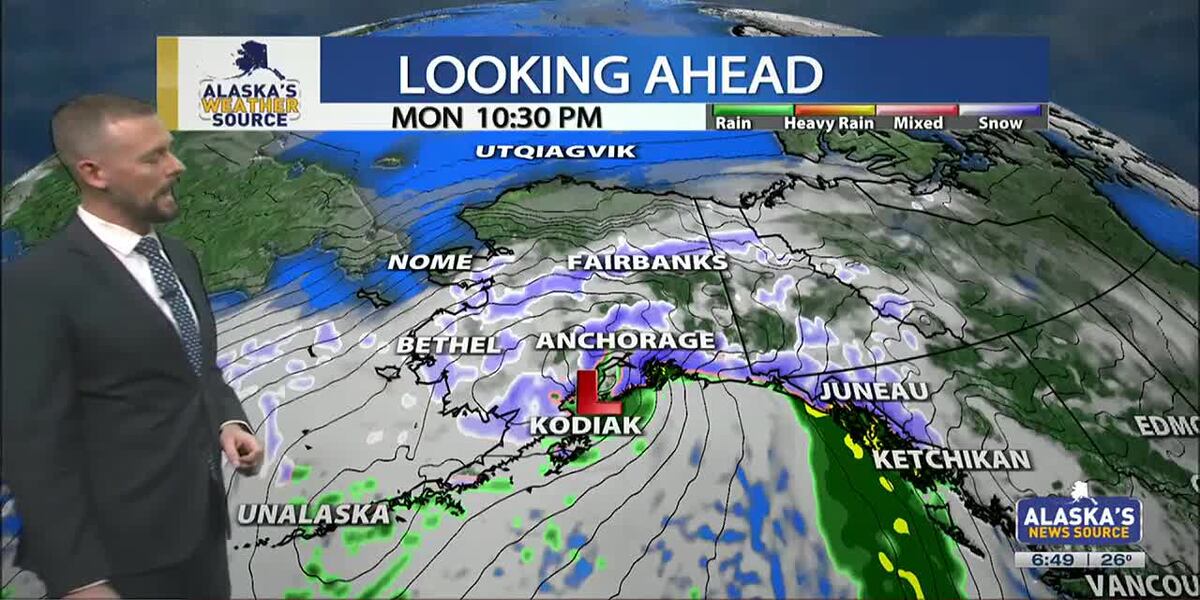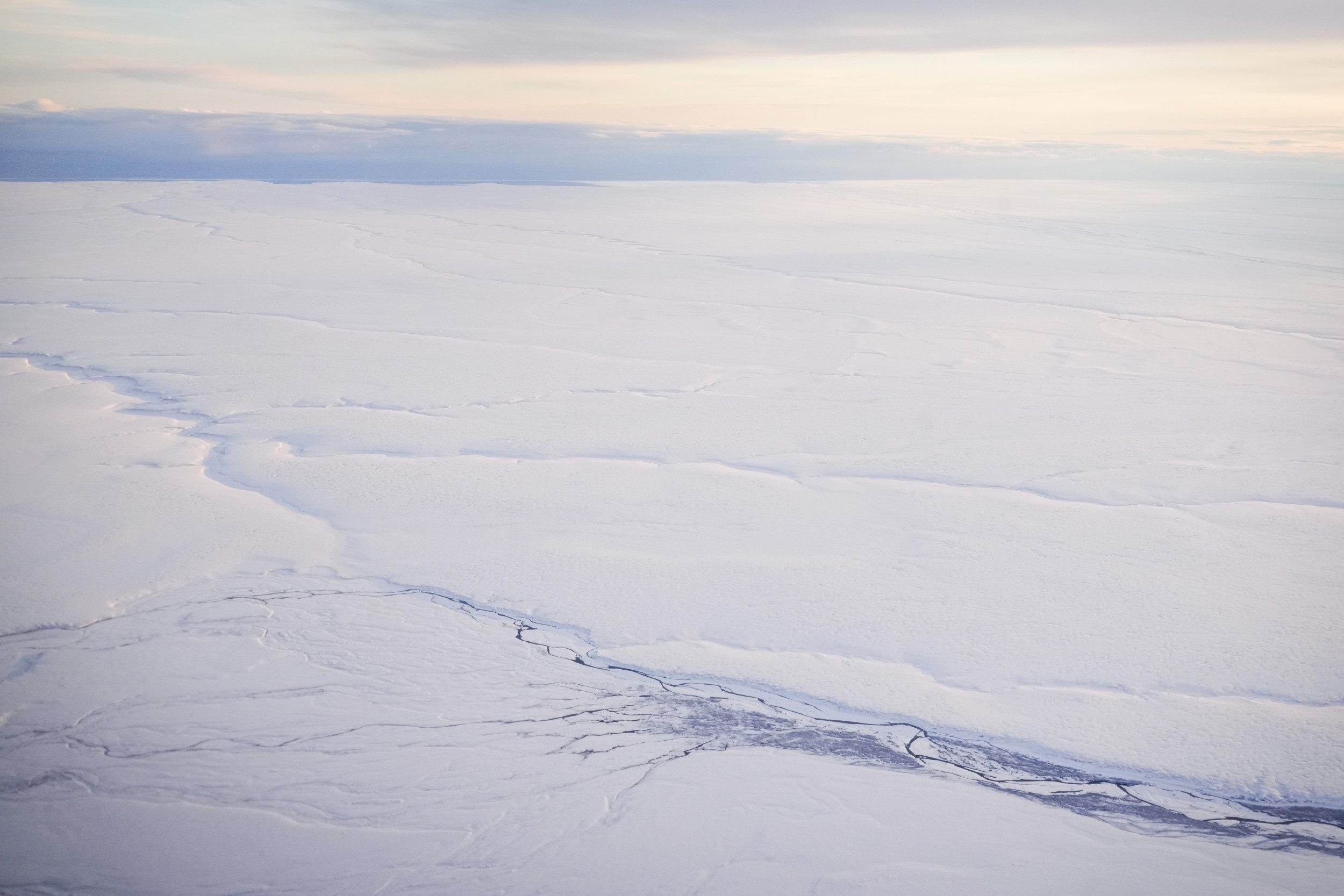ANCHORAGE, Alaska (KTUU) – Active weather is building back across Alaska with temperatures 10 to 30 degrees warmer than Sunday morning. This stretch of warm and wet weather will remain through the week with high winds impacting areas of Southcentral and the Alaska Range. The strongest winds will occur today (Monday), with winds gusting as high as 85 mph in some of the harder-hit areas.
SOUTHCENTRAL:
Most of Southcentral is waking up to a variety of weather alerts. From high winds to freezing rain, heavy rain to snow, Southcentral will see a mixed bag of precipitation impacting the region. This comes as a strong low moves out of the Northern Pacific Ocean and lifts northward through the Gulf of Alaska.
While the winds are not terribly gusty this morning, expect a gradual increase in winds through the afternoon. The strongest winds will occur through the Matanuska Valley, Anchorage Hillside, Turnagain Arm, Portage and Cordova. These locations can expect to see winds gusting as high as 75 mph, with higher wind gusts along the Anchorage Hillside and through Portage. It’s here where winds could gusts up to 85 mph, with occasional gusts of 100 mph for Portage. Be prepared for possible power outages and downed trees where winds whip the longest.
While the rest of Southcentral won’t see high winds, gusts of 20 to 50 mph still look possible. These winds will be responsible for a quick climb in temperatures today, with all of Southcentral seeing highs climbing above freezing. The potential for highs to climb well into the 40s will occur where winds remain the strongest and mixing occurs. The warmest stretch of weather looks to arrive this evening where the winds will remain the strongest.
In addition to the winds, a mixed bag of precipitation will fall across Southcentral. Expect hazardous roads wherever there is rain and freezing rain.
Rain will largely impact coastal areas, where 2 to 5 inches of accumulation looks likely through the middle of the week. Further inland where temperatures remain below freezing, a mix and/or freezing rain will occur through the first part of the day. Some areas of Southcentral have already seen light rain showers through the night, which led to a coating of ice on windshields left out in the elements. Up to a quarter of an inch of freezing rain is possible for parts of Southcentral, with the best potential for accumulation occurring in the Mat-Su Valley, Anchorage and into the Copper River Basin this evening. Western parts of the Kenai will see the potential for a glaze of ice, before enough warm air moves in to transition to rain.
While freezing rain and winds look to cause concerns for parts of Southcentral, heavy snow will also impact areas of the Copper River Basin and near Thompson Pass. While only 6 to 12 inches looks likely through the Copper River Basin, Thompson Pass could see 2 to 3 feet of snow accumulation. This could change as temperatures continue to steadily warm. Valdez is already sitting at freezing this morning, meaning the city could see more of a rain event, while the pass holds onto heavy wet snow.
Precipitation and winds die down into Tuesday, with only scattered areas remaining. While inland areas remain primarily dry through Wednesday, another storm system looks to arrive later this week. This upcoming storm could once again bring more winds, freezing rain and continued warmth for Southcentral.
SOUTHEAST:
A winter storm warning remains in effect for Skagway, Haines and Klukwan until noon. Two to 4 inches of snow will fall, with winds gusting up to 35 mph. As the snow tapers off, more snow and rain move in through the night. While snow and areas of wintry mix will primarily impact the Northern Panhandle, the rest of Southeast will see wet and windy conditions. As the rain builds in this evening, we’ll see 1 to 2 inches spread across the panhandle.
Active and wet weather looks to remain through much of the week. As a result, expect daily rain and winds will remain in the forecast. While some days will provide some much needed dry time, the overall weather pattern favors wet weather through the end of this week. We’ll see daily highs climbing into the 40s, keeping much of Southeast seeing rain. The only exception will be parts of the Northern Panhandle, where enough cold air remains that we could see pockets of wintry mix.
INTERIOR:
Temperatures in the Interior continue to warm, with many locations seeing highs 20 to 35 degrees warmer than last week. This week will bring very warm conditions to the Interior, with many locations warming into the 10s and 20s. The only exception will be for locations near the Alaska Range (highs expected in the 20s) and the Eastern Interior (highs in the 0s and 10s.).
Areas of the Alaska Range will see gusty winds develop throughout the day and linger through the middle of the week. Winds will gust upwards of 85 mph, with some of the strongest winds occurring north of Trims Camp. In addition to the winds, the Alaska Range will see several inches of snowfall. Blizzard conditions are possible, with 4 to 7 inches of snow accumulation. Most of the snow will fall in the Southern Denali Borough and the Eastern Alaska Range, south of Trims Camp.
While no alerts are in place, snow will also spread north through the Interior this week. Up to an inch of snow, if not slightly more, is expected for the rest of the Interior through the middle of the week. While this shouldn’t lead to any traffic issues, as temperatures warm this week, we could see some slick spots develop across parts of the Interior.
Daily highs for Fairbanks will warm well into the 10s and 20s, with an outside chance we could see a few 30s popping up across the Interior. While the better chance for that will be near the Alaska Range, inland areas of the Interior will also see a stretch of warmer weather.
SLOPE/WESTERN ALASKA:
Cold weather remains for the Slope, with gusty winds expected to stick around through the day. This will lead to some areas of blowing snow and wind chills near -40 in some spots. Strong winds look to impact parts of the Western Brooks Range, where gusts up to 60 to 70 mph look possible. As a result of this, a high wind warning goes into effect later today through Tuesday evening.
While little to no snow is expected for much of the Slope, areas fo the Beaufort Sea Coastline and Arctic Plains could see a few inches of accumulation this evening through Wednesday. 1 to 3 inches looks possible for the immediate coastline, with areas of the Brooks Range seeing 3 to 5 inches. If you’re traveling through Atigun Pass, be prepared for blowing snow and visibility down to half a mile at times.
While things will remain largely dry for Western Alaska, gusty winds will be an issue today. Winds of 30 to 70 mph look possible, with areas of blowing snow leading to reduced visibility. Although not as warm, Western Alaska will see highs today climbing into the 10s. With strong winds sticking around, many areas will see wind chills remain well below zero today.
Through Southwest Alaska, scattered to periodic snow showers look to remain in the forecast. 3 to 6 inches looks to be the best bet for most locations, with the heaviest snow falling from Dillingham, northeast to Koliganek and Stuyahok. While snow looks to be the primary precipitaton today, warmer weather tomorrow could lead to some areas of rain and snow for southwest.
ALEUTIANS:
Light rain showers and winds are impacting the Aleutians this morning, with less than a quarter of an inch for most areas. While some areas of the Alaska Peninsula may see some light snow showers, a warmer push of air will lead to most areas seeing rain in the forecast. We’ll keep with gusty winds and mild temperatures this week, as daily highs warm into the 30s and 40s.
One thing to watch will be increasing winds for parts of St. Lawrence Island and parts of the Bering Sea, where winds will remain quite gusty. Gusts up to 60 mph will be possible, with areas of freezing spray for the Bering Sea, Pribilofs, Nunivak island and areas of St. Lawrence Island.
OUTLOOK AHEAD:
A warmer weather pattern looks to grip much of the state for the next few weeks. Daily highs will likely stay at or above freezing in Southcentral, with the Interior not dropping back below zero until late next week. Numerous storm systems look to take aim on Alaska over the next 2 weeks, with a mixed bag of precipitation to be expected. There’s not good chance of snow in the forecast for Anchorage and surrounding locations. While we could see a brief opportunity for snow over the next week, expect little accumulation if any.
Have a safe and wonderful start to your week.
See a spelling or grammar error? Report it to web@ktuu.com
Copyright 2025 KTUU. All rights reserved.










:quality(70)/cloudfront-us-east-1.images.arcpublishing.com/adn/RQGAA7VDAJA7LDNXJLOHEDDWUU.jpg)
:quality(70)/cloudfront-us-east-1.images.arcpublishing.com/adn/WQH5BIXUQVH7BHPT6SUKSVUSEU.JPG)















/cdn.vox-cdn.com/uploads/chorus_asset/file/24982514/Quest_3_dock.jpg)





